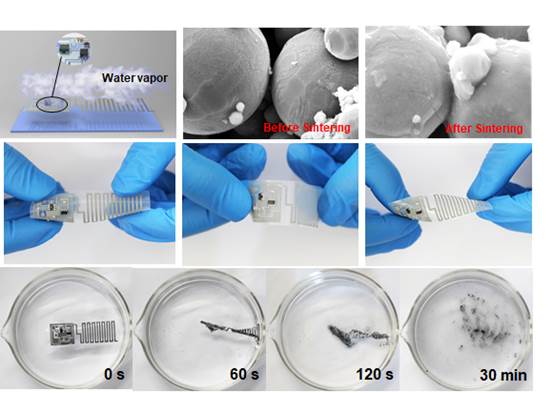Recently, Professor Huang Xian’s team from Tianjin University’s School of Precision Instruments and Opto-Electronics Engineering successfully developed the printing technology of "water sintering", which for the first time in the world has realized the production of bioresorbable flexible electronic components with low energy consumption and low cost. Relevant research results have been published in the authoritative international journal Advanced Functional Materials.
Flexible electronic devices like folding computers, folding mobile phones and wearable digital products are attracting more and more attention. Such devices can work while being bent, folded, twisted, compressed or stretched, and is potentially very promising in such areas as energy sources, medical care and information and communication. Flexible electronic printing methods are key to the manufacture of flexible electronic devices. The theory is to use precision printing technology to make electronic devices or circuits where color-expressing ink is replaced with electronic functions, enabling the graphics printed on the flexible substrate to have electronic functions. Current mainstream international processing methods for flexible electronic printed graphics include high temperature heating,laser sintering and optical pulse sintering, etc. These printing methods are expensive and prone to damage the circuit substrate.
Professor Huang Xian's team presented a flexible electronic printing technology of "water sintering". The team developed a new nanometer metallic conductive ink and a new sintering method that uses water vapor to create flexible electronic circuits at room temperature without the need for high temperatures, lasers or high intensity light pulses . It is particularly worth mentioning that the flexible electronic components produced by this "water-induced sintering" method can work stably for a long time under normal operating conditions, and can achieve non-toxic degradation under specific humidity, which appears to possess good bioresorbability, and have a broad prospect in the field of biomedicine.
According to Professor Huang Xian, the printing technology of "water sintering" and nano conductive ink can eliminate the need for users to buy expensive sintering equipment. The cost of mass production of flexible electronic components is expected to drop to 1% of the current cost. "The handling and processing technology of new flexible electronic components will greatly benefit the large-scale commercial production of bioresorbable flexible electronic devices."

Illustration: The schematic diagram of water-induced sintering and the comparison before and after sintering, as well as the flexibility display and dissolution characteristics of the device after sintering.
By Luo Yumeng
Editors: Eva Yin & Doris Harrington






